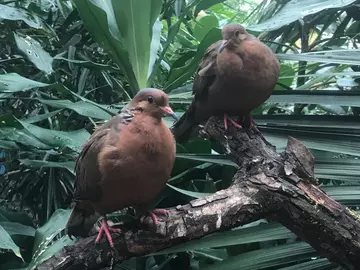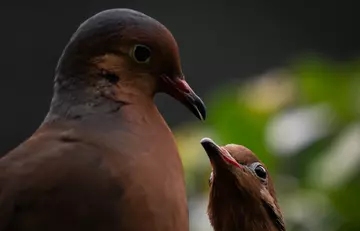
Extinct-in-the-Wild doves welcomed, as part of project to restore the species to the wild
An international effort to save a species from being lost forever has seen three Extinct-in-the-Wild birds move to London Zoo - as part of a global partnership to breed and reintroduce them to the wild.
The Socorro dove, a beautiful bird endemic to a tiny island off the coast of Mexico, exists only in human care, and we, along with partners around the world, are on a mission to restore the species to the wild.

The three doves, which moved from Portugal’s Lagos Zoo at the end of 2024, have settled into their new home, joining other six Socorro doves at the conservation zoo. The move also included two additional Socorro doves soon bound for Chester Zoo, where they will join its breeding programme for the highly threatened species.
The arrival of these doves represents an important milestone for the Socorro Dove Project, an international initiative working to reintroduce this Extinct-in-the-Wild species to Mexico’s Socorro Island by 2030. The project is a collaboration between ZSL (the conservation charity behind London Zoo), key partners in Mexico, Frankfurt Zoo, Africam Safari, and other institutions within the EAZA (European Association of Zoos and Aquariums) and AZA (Association of Zoos and Aquariums) networks, dedicated to safeguarding the species.

Gary Ward, our Curator of Birds, said, “Welcoming three new Socorro doves to London Zoo is an exciting step in our mission to bring this species back from the brink of extinction. Following their trip from Portugal, the birds all spent a short time in quarantine, now that’s complete, they have been introduced to their future mates. We’re hopeful that these new pairings will help boost the global population of this Extinct-in-the-Wild species.”
Adrian Walls, our Team Leader for Tropical Birds, said, “Once they’d finished their quarantine and we brought the three new doves into the Blackburn Pavilion, we were sure to give them some time to settle into their new home, as well as some of their favourite foods – a mixture of seeds, pellet and fruit.
“For us, the next step is introducing them each, one by one, to their potential mates in separate flying areas of the Pavilion, to let them get to know each other. Once our job as matchmaker is done, the Socorro doves will live as pairs and we will hopefully be one step closer to seeing some precious Socorro dove chicks this year.”

Gary added, “With their rusty-brown feathers, these doves may look unassuming, but thanks to the vital role they fill in their wild habitat, they are one of the most precious species we care for. Our goal for the international Socorro Dove Project is to restore this species back to their native island, where they’ll resume their role as seed dispersers, helping endemic plants thrive and restoring balance to this unique environment.”
Once abundant on Socorro Island, part of Mexico’s Revillagigedo Archipelago, the Socorro dove was last seen in the wild in 1971. Like many island species, its ground-dwelling nature and lack of fear of predators made it especially vulnerable. While domestic cats introduced in the 1950s are often blamed for their extinction, habitat destruction caused by feral sheep had already decimated the population by the end of the 19th century. The species was officially declared Extinct-in-the-Wild in 1972.
To ensure the protection of the species, 17 doves were brought into zoos for conservation programmes in 1926, and the dove survives today in carefully managed breeding efforts across Europe and the United States, which ensure the genetic diversity of the dove population – crucial to the success of the reintroduction project. Today, only 189 individuals remain, cared for in a network of 46 zoos worldwide.
Ahead of the planned 2030 reintroduction efforts, major habitat restoration work is already underway on Socorro Island, which was declared a biosphere reserve in 1994: feral sheep have been removed from the island, and native plants critical to the dove’s survival have been reintroduced. This habitat restoration is thought to not only benefit the Socorro dove, but other critically endangered and endangered species on the island, such as the Socorro Mockingbird and the Socorro Blue Lizard.
Visitors can see the Socorro doves in Blackburn Pavilion, London Zoo’s historic tropical birdhouse, which is also home to the Endangered Sumatran laughingthrush, Critically Endangered Bali starling and the Critically Endangered blue-crowned laughingthrush.
